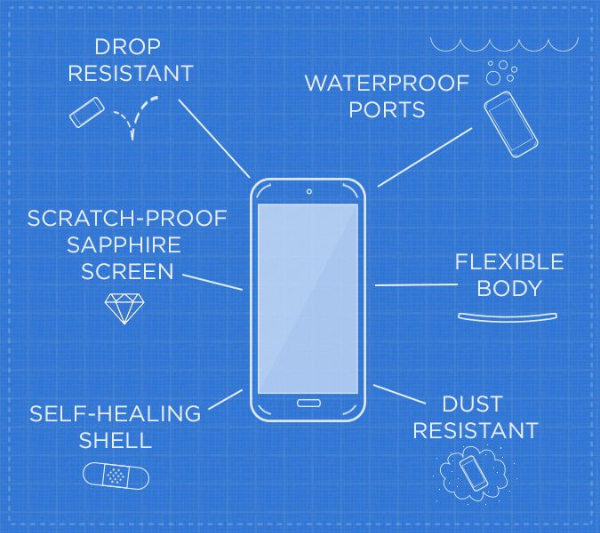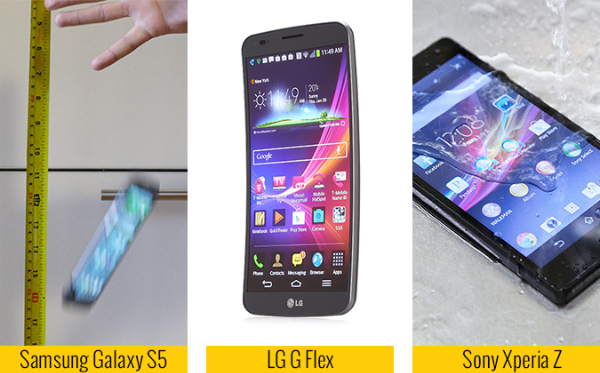The Indestructible Smartphone Is Closer Than You Think
Will a mainstream smartphone ever be unbreakable? Thanks to new materials and innovative manufacturers, we're closer than ever before.

We’ve all been there before. You’re casually strolling the streets while sending a text on your smartphone, and it slips out of your hand. Or maybe you left your device a bit too close to your pool, dog or child without supervision. Either way, there’s a good chance you’ve destroyed your most beloved device due to an everyday accident.
But what if our handsets could handle more?
It only takes one mistake to render our most valuable device unusable, but hardware manufacturers have the power to change that. Handsets like the Samsung Galaxy S5, Sony Xperia Z and LG G Flex ship with features like water resistance and self-healing shells, making your device less prone to spills and scratches right out of the box.
The advancements don’t stop there. Protective phone-case designers are constantly coming up with more resilient tech, and researchers are discovering materials that can make our devices stronger than steel.
So what will it take to put an unbreakable device in your hands? And how soon will it arrive?
Why We Need Tougher Phones
“Smartphones were always as indestructible as an egg,” said tech analyst Jeff Kagan. And while it might seem silly to compare our handsets to a fragile dairy item, the numbers don’t disagree.
According to SquareTrade, a company that offers protection plans for cell phone owners, 1 in 3 people break their device within a year of owning it. All of that damage adds up; the company claims that roughly $13 billion has been spent on smartphone repair over the past five years.
MORE: A Comparison of Cellphone Insurance Plans
“I’ve never talked to someone who never dropped their phone,” said SquareTrade Communications Manager Jessica Hoffman.
Hoffman notes that the company’s most common damage claims come from everyday occurrences, like dropping your device on the ground, accidentally sliding it off a table or letting it fall out of your lap after exiting a vehicle.

Parents are especially at risk, according to SquareTrade, as the company’s data shows that over half of moms and dads report that their children have damaged their devices.
These slip-ups have made shattered screens an all-too-common occurrence, as Hoffman claims that 5 percent of smartphone owners are walking around with a cracked display. There’s also the dreaded toilet drop; SquareTrade reports that 1 out of 10 Americans have accidentally immersed their smartphones in the bathroom.
Damage statistics aside, smartphones are simply too important to everyday life to leave vulnerable anymore. “We have to move toward a time when the smartphone is almost indestructible, and the reason is simple: It’s the remote control of our lives,” said Kagan.
“Today we use it for communicating … but tomorrow we’re going to be using it and not carrying a wallet, not carrying keys, it’s going to open the house door, car door and garage, and it’s going to have all of our insurance information,” he added.
The State of Durability
Today’s phones aren’t indestructible, but many modern handsets boast some impressive ruggedness. Samsung’s Galaxy S5 sports an IP67-certified water-resistant chassis that can withstand spills. The S5 Active for AT&T steps things up with both drop resistance and dust resistance.

There’s also the LG G Flex. In addition to its bendable body, the handset features a resin-based, “self-healing” back panel that can make everyday scratches go away.
According to Hoffman, the S5 in particular marks a significant step forward for Samsung’s flagship smartphone line.
“Samsung phones have been notoriously terrible,” said Hoffman, referring to their performance on SquareTrade’s breakability tests. The company measures how well a smartphone holds up during a 5-foot drop test, and slides each of its smartphones across a wooden table to see how likely it is to slip off your desk. The firm also performs a water test, in which it submerges a smartphone (which is actively playing a video) in a few inches of water for 10 seconds in order to see if the device stops working. Each device is then given a breakability score from 1 to 10, with 10 being the most breakable.
The Galaxy S5’s breakability score of 6 is the best a Galaxy device has achieved, as the new model managed to survive the company’s water and drop tests. The S4 failed SquareTrade’s drop test in 2013, and the protection group noted that the former flagship model was one of the more fragile that they’ve tested.
MORE: Samsung Galaxy S5 User Guide
According to IDC Research Manager Ramon Llamas, the average smartphone design makes it prone to destruction from the start.
“We get the notion that thin is in, and the bigger the screen the better,” said Llamas. “Those two factors are an easy recipe for smartphone breakage.”
Overall, there are some attractive durable smartphone options today, but there’s still a long way to go.
Get instant access to breaking news, the hottest reviews, great deals and helpful tips.
The ‘Wonder Material’
While the inner workings of modern smartphones are constantly improving, creating a smartphone that’s virtually indestructible will take a special combination of guts.
Among the materials that could significantly strengthen our phones is graphene, a form of carbon that has had the tech world abuzz as of late. Touted by some as the “wonder material,” graphene’s carbon atoms are arranged in two-dimensional sheets, resulting in highly flexible and durable structures.
Graphene was first discovered in 2004, though companies have struggled to find a way to mass manufacture the material. However, Samsung’s Advanced Institute of Technology recently announced the discovery of a “groundbreaking method” for producing graphene — one that can make it one of the core building blocks of tomorrow’s mobile devices.
In addition to being extremely thin and malleable, graphene is reportedly 200 times stronger than steel. The material is also highly resistant to water.
According to a study from the American Chemical Society, touch screens that use graphene as their main conductive element could be printed on a thin layer of plastic instead of the glass you see on most handsets. This would make the average smartphone thinner than ever and foldable like paper. According to ACS, this approach would allow handsets to be “nearly unbreakable.”
“Graphene is very unique in a number of ways,” said Jiwoong Park, associate chemistry and chemical biology professor at Cornell University. “It’s very conductive, very tough, very, very transparent and very bendable. The combination of these properties has never been observed from a single material.”
Park notes that while graphene has the potential to become part of a “new type of device architecture,” today’s manufacturers still need to figure out how to harness that potential. The professor likens its usefulness to Corning’s now-ubiquitous Gorilla Glass, which existed long before there was a need for it.
“Given its physical form and its exciting properties, (graphene) could be very useful in the future,” Park continued. “But exactly how we’ll be using it has yet to be determined.”
Despite its vast potential, not everyone is sold on graphene.
“How expensive is this material?” asked Llamas, referring to graphene. “There’s a reason Samsung puts out its flagship device with a relatively flimsy plastic shell. They’re cheap to make and they know consumers are going to buy a case.”
As far as this “wonder material” goes, Llamas said that “we’re still looking at the theoreticals at this point.”
In addition to graphene being unproven in a practical sense, it also might be bad for our well-being. A scientific study from Brown University reveals that graphene nanoparticles have sharp edges that could easily penetrate our lungs and skin. A separate study from the University of California suggests that if graphene was to spill, it could spread quickly and cause damage to the environment and its inhabitants.
Stronger with Sapphire
Graphene isn’t the only material with game-changer promise. Apple is reportedly tapping GT Advanced Technologies to create sapphire glass for its future phones, which means we may someday have an iPhone with a screen that’s virtually impossible to scratch or crack.
Sapphire glass isn’t technically glass. Rather, it’s a highly transparent form of sapphire itself, which is only second to diamond in terms of material hardness. Sapphire has a density of 3.98 grams per cubic centimeter, making it denser than the 2.54 g/cm3 Gorilla Glass found on current iPhone screens.
Sapphire has some serious real-world potential: The folks at Aero Gear tested the material by dragging a massive concrete brick over a screen made of sapphire crystal. Despite how cringe-worthy the process looks in motion, the sapphire screen came out of the process completely unscathed.
The rise of sapphire screens could pose a serious threat to Corning, whose Gorilla Glass technology is found on 2.7 billion devices, including handsets from Samsung, HTC, LG, Nokia and Motorola.
Gorilla Glass marketing head Dave Velasquez said that the company has worked with sapphirelike materials and praises the anti-scratch capabilities of sapphire. However, he’s confident about sticking with the Gorilla Glass substrates, which have made the company a household name in the smartphone industry.
“We’ve been deeply involved with testing different types of materials, and we’ve made our decision to stick with glass solutions,” said Velasquez. “We like that we can add things like anti-reflective coating and shape the glass, and [it’s] just lower-cost.”
Bringing Workplace Ruggedness to the Masses
There might not be an iPhone or Galaxy that can be tossed off a tall building and keep ticking, but that doesn’t mean that there aren’t phone makers blazing new trails in durability. Take Sonim, an enterprise-minded manufacturer that develops feature phones for harsh conditions. In 2011, the company’s XP3300 set a mark recognized by the Guinness World Records for World’s Toughest Phone, after surviving an 82-foot drop onto bare concrete.
“It takes a lot more than taking a smartphone and putting rubber around it,” said Sanjay Jhawar, VP of marketing and GM of solutions for Sonim.
The black-and-yellow builds of Sonim products like the Enduro flip phone and XP Strike candybar might not win any style points, but they sport impressive rugged features, like the ability to withstand 6.5-foot drops and 6.5-foot underwater submersion.

“You have MIL-SPEC-tested phones, but a MIL-SPEC drop is only 4 feet onto plywood,” said Jhawar. “[Workplaces] don’t have 4-foot employees that walk around on wood all day. They have 6-foot ones that walk on concrete.”
Sonim handsets boast waterproof speakers and charger ports, which eliminate the need for pesky cover flaps like that of the Samsung Galaxy S5. And while Sonim’s product line is currently limited to devices built for construction sites and oil rigs, the company is prepping its first-ever smartphone that will fuse mainstream usability with the rugged features on which the brand built its name.
Making a Case for Durability
Not all smartphones can take a beating out of the box, but protective case makers have been augmenting device durability for years.
“Look at the different kinds of cases you can get,” said IDC’s Llamas. “That says to me that [smartphones] were not intended by design to be indestructible.”
One of the leaders of the case market is OtterBox, a company that got its start in 1998 making waterproof dry boxes for small valuables. Today, the brand creates highly durable shells for popular smartphones, including its drop-resistant Defender series and waterproof Preserver series.
“Our cases are a way of offering features and functions that go beyond what your phone itself offers,” said Tom Davison, Otterbox’s global director of engineering and technology.
Davison may be right, but protective cases have their downfalls. For starters, good ones don’t come cheap. The Armor series has a retail value of $99, which is how much some entire smartphones cost with a contract.
There’s also the aesthetic issue. Devices like Apple’s iPhone 5s and the HTC One M8 sport premium metal bodies with silver and gold finishes, so why would you want to cover those up?
“Shock-resistant and water-resistant cases [are] too bulky,” said Kagan. “They work miracles, but you have to be willing to carry a brick around.”
If a near-indestructible smartphone is to succeed, manufacturers need to find a way to implement the crucial components of protective cases within the device’s DNA. Perhaps big brands can take some inspiration from Sonim, which uses a dual-injection molding process for its phones. A shock-absorbent soft plastic and a hard plastic are injected into a single mold, which, according to Jhawar, helps keep each device both lightweight and tough.
Outlook
Given the technology at manufacturers’ disposal, when can we expect to see a near-indestructible smartphone? According to Kagan, it could happen as soon as one or two years from now.
“This is 2014, there’s no reason we can’t make anything waterproof or shockproof anymore.” said Kagan, who believes that if one manufacturer offers up a highly durable mainstream phone, others will follow suit. “It’s up to the phone makers. They need to want to do it.”
According to Llamas, it’s going to take some creativity on the manufacturing side for us to have a nearly unbreakable device in our hands.
“You’re going to have to see some experimentation with materials. Until we reach that point, we have people that have no problem paying an extra $30 for a case,” said Llamas.
Gorilla Glass’ Velasquez laughed when asked when he expects to see a fully indestructible device, though he’s excited about what his company will be bringing to market. He wouldn’t dish specifics, but noted that Corning’s upcoming product will “address those attributes that consumers really care about.”
“We’re not going to rest. As long as cover glass breaks or scratches, we’re going to continue to attack those problems,” said Velasquez. “Stay tuned.”
Mike Andronico is Senior Writer at CNNUnderscored. He was formerly Managing Editor at Tom's Guide, where he wrote extensively on gaming, as well as running the show on the news front. When not at work, you can usually catch him playing Street Fighter, devouring Twitch streams and trying to convince people that Hawkeye is the best Avenger.

